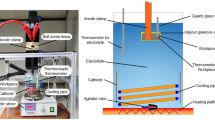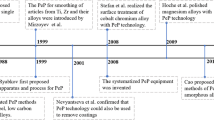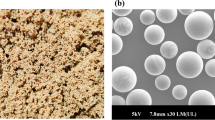Abstract
Electrochemical polishing (ECP) is widely used for scratch- and damage-free finishing of metal components. Though the polishing effect of ECP has been confirmed in many researches, the influence of polishing parameters on evolution of surface roughness is still ambiguous owing to the use of different ECP systems. In this paper, the universal factor determining the evolution of surface roughness during ECP is studied by theoretical analysis as well as experiments. Theoretical analysis based on viscous layer mechanism demonstrates that the material removal thickness is the key parameter governing the roughness evolution of the polished surface regardless of other parameters including the voltage and current and electrolyte concentration. A series of experiments were designed and carried out to verify the proposed hypothesis. Both the experimental results and already published researches proved the validity and universality of the newly developed hypothesis on surface roughness evolution. This work is of great significance for further understanding the finishing mechanism of ECP and process control for its practical applications.








Similar content being viewed by others

Availability of data and materials
All data generated or analyzed during this study are included in this published article.
References
Deng H, Endo K, Yamamura K (2015) Competition between surface modification and abrasive polishing: a method of controlling the surface atomic structure of 4H-SiC (0001). Sci Rep 5:8947. https://doi.org/10.1038/srep08947
Zhou L, Audurier V, Pirouz P, Powell J (1997) Chemomechanical polishing of silicon carbide. J Electrochem Soc 144:161–163. https://doi.org/10.1149/1.1837711
Zhai W, Gao B, Chang J, Wang H (2019) Optimization of ultrasonic-assisted polishing SiC through CFD simulation. Nanomanuf Metrol 2:36–44. https://doi.org/10.1007/s41871-018-0033-8
Murata J, Yodogawa K, Ban K (2017) Polishing-pad-free electrochemical mechanical polishing of single-crystalline SiC surfaces using polyurethane-CeO2 core-shell particles. Int J Mach Tool Manuf 114:1–7. https://doi.org/10.1016/j.ijmachtools.2016.11.007
Deng H, Hosoya K, Imanishi Y, Endo K, Yamamura K (2015) Electro-chemical mechanical polishing of single-crystal SiC using CeO2 slurry. Electrochem Commun 52:5–8. https://doi.org/10.1016/j.elecom.2015.01.002
Deng H, Huang R, Liu K, Zhang XQ (2017) Abrasive-free polishing of tungsten alloy using electrochemical etching. Electrochem Commun 82:80–84. https://doi.org/10.1016/j.elecom.2017.07.030
Han W, Fang FZ (2019) Fundamental aspects and recent developments in electropolishing. Int J Mach Tool Manuf 139:1–23. https://doi.org/10.1016/j.ijmachtools.2019.01.001
Ajmal KM, Yi R, Zh ZJ, Ji JW, Zhang XQ, Deng H (2021) Highly efficient smoothing of Inconel 718 via electrochemical-based isotropic etching polishing. Precis Eng 71:119–129. https://doi.org/10.1016/j.precisioneng.2021.03.005
Walton HF (1936) The anode layer in the electrolytic polishing of copper. J Electrochem Soc 97:219–226. https://doi.org/10.1149/1.2777996
Hoar TP, Mowat JAS (1950) Mechanism of electropolishing. Nature 165:64–65. https://doi.org/10.1038/165064a0
Grimm RD, West AC, Landolt D (1992) AC impedance study of anodically formed salt films on iron in chloride solution. J Electrochem Soc 139:1622–1629. https://doi.org/10.1149/1.2069467
Matlosz M, Magaino S, Landolt D (1994) Impedance analysis of a model mechanism for acceptor-limited electropolishing. J Electrochem Soc 141:410–418. https://doi.org/10.1149/1.2054741
Chkhalo NI, Churin SA, Pestov AE, Salashchenko NN, Vainer YA, Zorina MV (2014) Roughness measurement and ion-beam polishing of super-smooth optical surfaces of fused quartz and optical ceramics. Opt Express 22:20094–20106. https://doi.org/10.1364/OE.22.020094
Hoyo JD, Choi H, Burge JH, Kim GH, Kim DW (2017) Experimental power spectral density analysis for mid- to highspatial frequency surface error control. Appl Opt 56:5258–5267. https://doi.org/10.1364/AO.56.005258
Ji JW, Fan W, Gao W, Wang C, Zhang YF, Xu M, Ji F (2019) Investigation of roughness evolution of ion sputtered fused silica surface. Appl Opt 58:5388–5396. https://doi.org/10.1364/AO.58.005388
Wang F, Zhang X, Deng H (2019) A comprehensive study on electrochemical polishing of tungsten. Appl Surf Sci 475:587–597. https://doi.org/10.1016/j.apsusc.2019.01.020
Nave MI, Allen JP, Chen-Wiegart Y-C, Wang J, Kalidindi SR, Kornev KG (2015) In situ X-ray nanotomography of metal surfaces during electropolishing. Sci Rep 5:15257. https://doi.org/10.1038/srep15257
Simka W, Mosiałek M, Nawrat G, Nowak P, Żak J, Szade J, Winiarski A, Maciej A, Warszynska LS (2012) Electrochemical polishing of Ti-13Nb-13Zr alloy. Surf Coat Tech 213:239–246. https://doi.org/10.1016/j.surfcoat.2012.10.055
Choi SG, Kim SH, Choi WK, Lee ES (2016) The optimum condition selection of electrochemical polishing and surface analysis of the stainless steel 316L by the Taguchi method. Int J Adv Manuf Technol 82:1933–1939. https://doi.org/10.1007/s00170-015-7404-8
Acknowledgements
The authors acknowledge the assistance of SUSTech Core Research Facilities.
Funding
This work is financially supported by the National Natural Science Foundation of China (Grant No. 52035009, 52005243) and the research fund from the Science and Technology Innovation Committee of Shenzhen Municipality (JCYJ20200109141003910), Shenzhen, China.
Author information
Authors and Affiliations
Corresponding author
Ethics declarations
Ethical approval
Not applicable.
Consent to participate
Not applicable.
Consent for publication
Not applicable.
Competing interests
The authors declare no competing interests.
Additional information
Publisher's Note
Springer Nature remains neutral with regard to jurisdictional claims in published maps and institutional affiliations.
Rights and permissions
About this article
Cite this article
Ji, J., Khan, .A., Zhan, Z. et al. Material removal thickness: a universal factor determining the evolution of surface roughness in electrochemical polishing. Int J Adv Manuf Technol 120, 5755–5762 (2022). https://doi.org/10.1007/s00170-022-09129-9
Received:
Accepted:
Published:
Issue Date:
DOI: https://doi.org/10.1007/s00170-022-09129-9



